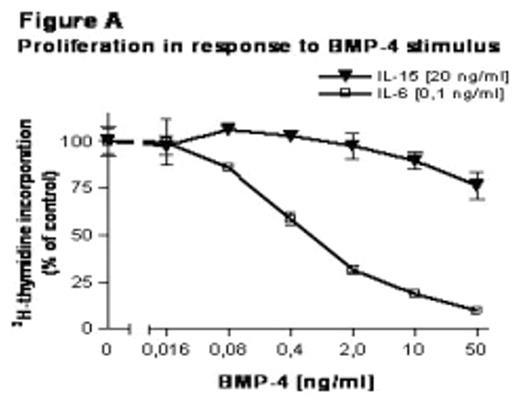Abstract
Multiple myeloma has two distinct features: Expansion of malignant plasma cells within the bone marrow accompanied by skeletal destruction. Bone morphogenetic proteins (BMPs) have been shown to induce apoptosis and inhibit growth in myeloma cells. BMPs are members of the TGF-β superfamily of proteins capable of inducing bone formation, and regulate proliferation, differentiation and apoptosis. We have investigated myeloma cell apoptosis and proliferation with BMP-4 and −6 in concert with the myeloma cell growth factors interleukin (IL)-2, IL-6, IL-10, IL-15, IL-21, tumor necrosis factor (TNF)-α and insulin-like growth factor (IGF)-1. Eight samples of highly purified myeloma cells from patients and a human myeloma cell line, IH-1 (Brenne AT et al. Blood. 2002 May 15;99(10):3756–62.), were used in this study. Cytokine concentrations used in the referred experiments were for BMP-4 20ng/ml, BMP-6 250ng/ml, IL-15 20ng/ml and IL-6 0,1ng/ml, respectively. Growth inhibition was measured in a proliferation assay by methyl-[3H]-thymidine incorporation and apoptosis by annexin V- FITC-binding/PI-uptake on flow cytometry. IL-15 antagonized growth inhibition (Figure A) and prevented apoptosis induced by BMP-4 (Figure B) and BMP-6 in the myeloma cell line IH-1. IL-15 also antagonized the growth inhibition induced by BMP-4 and/or BMP-6 in three out of eight patient samples. Neither IL-6, nor any of the other investigated cytokines were able to rescue the myeloma cells from growth inhibition and apoptosis induced by BMP-4 and -6. Among the investigated cytokines, we found that IL-15 has a unique capability to antagonize BMP- induced apoptosis and growth inhibition in myeloma cells. We examined cleavage of the proapoptotic protein caspase-3 and found that BMP-4 activated caspase-3 in the IH-1 cell line. This activation of caspase-3 was blocked by IL-15 but not by IL-6. We have demonstrated a possible mechanism for myeloma cells to escape apoptosis and growth-inhibition within the bone marrow. Intramedullar levels of IL-15 and BMPs may play a role in the pathogenesis of multiple myeloma.
Disclosures: From the Norwegian Cancer Society, The Norwegian Research Council and from Cancer Fund, St. Olavs University Hospital, Trondheim, Norway.
Author notes
Corresponding author



This feature is available to Subscribers Only
Sign In or Create an Account Close Modal